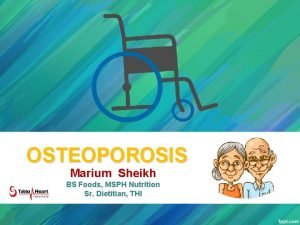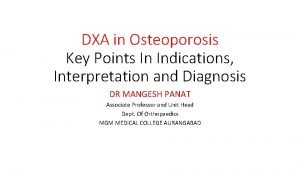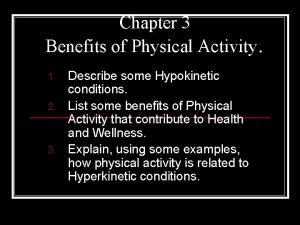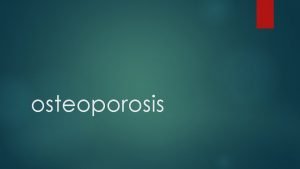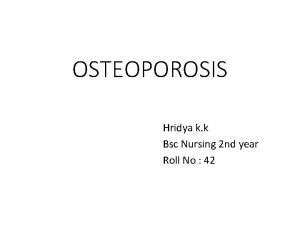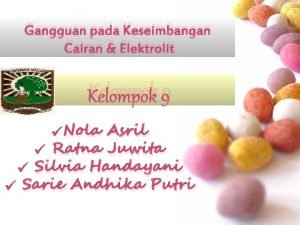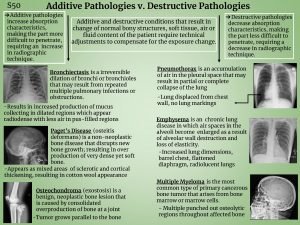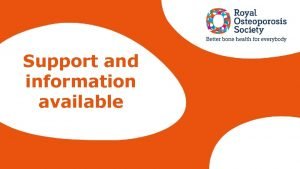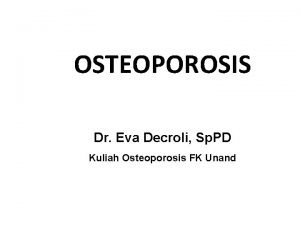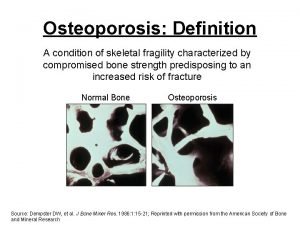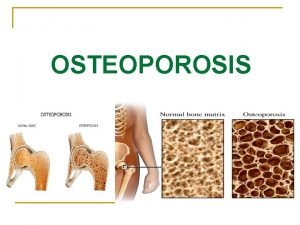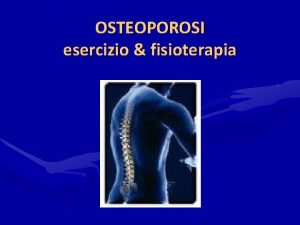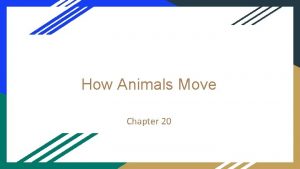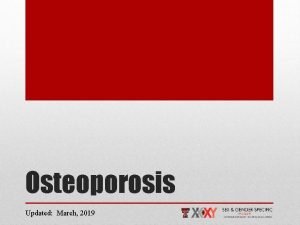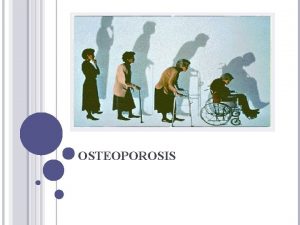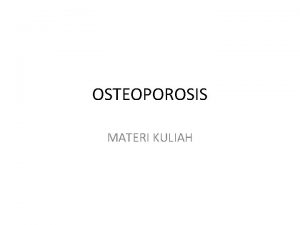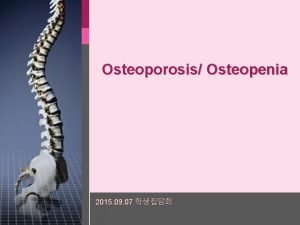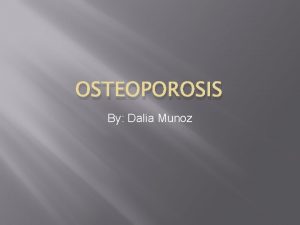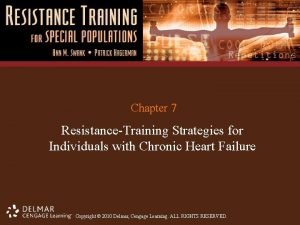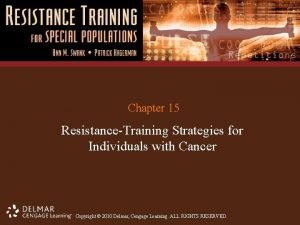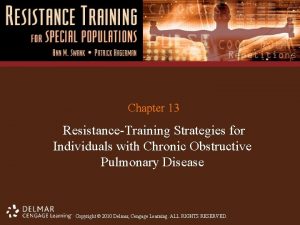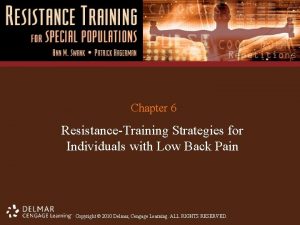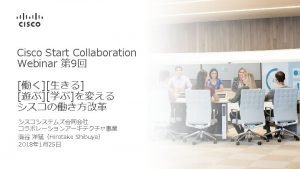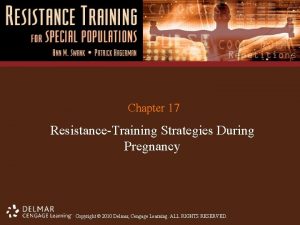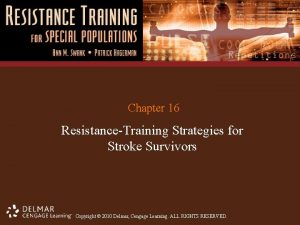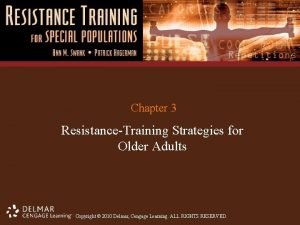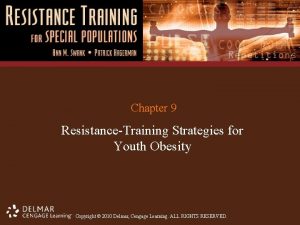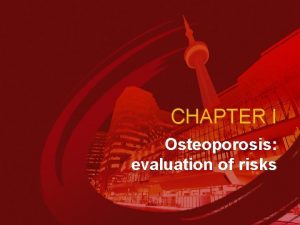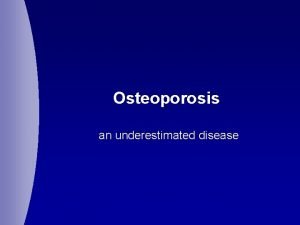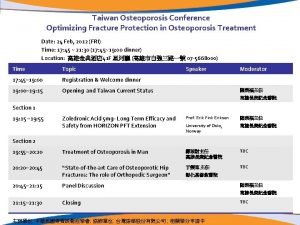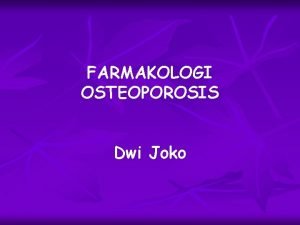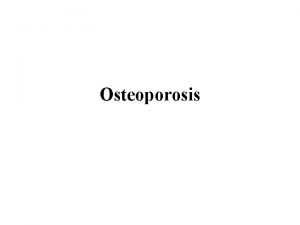Chapter 4 ResistanceTraining Strategies for Individuals with Osteoporosis















































- Slides: 47

Chapter 4 Resistance-Training Strategies for Individuals with Osteoporosis Copyright © 2010 Delmar, Cengage Learning. ALL RIGHTS RESERVED.

Osteoporosis Overview • Also known as brittle bone disease • Means “porous bone” • Erodes bone tissue until it becomes fragile and breaks Copyright © 2010 Delmar, Cengage Learning. ALL RIGHTS RESERVED.

Osteoporosis Overview • Osteopenia – Low bone density – Precursor to osteoporosis • Resistance training helps prevent Copyright © 2010 Delmar, Cengage Learning. ALL RIGHTS RESERVED.

Prevalence of Osteoporosis • Affects approximately 10 million Americans over age 50 • Approximately 34 million Americans have osteopenia • Annual fracture rates from weak bones affect 1. 5 million Americans Copyright © 2010 Delmar, Cengage Learning. ALL RIGHTS RESERVED.

Prevalence of Osteoporosis • By 2020, half of all Americans age 50 or more will have osteopenia and/or osteoporosis unless prevention measures implemented • Predominantly affects small-framed Caucasian and Asian women Copyright © 2010 Delmar, Cengage Learning. ALL RIGHTS RESERVED.

Prevalence of Osteoporosis • Non-Hispanic black women and Mexican. American women at lower risk • Fracture risk for women: – Age 50 = 9. 8 percent – Age 80 = 21. 7 percent • Wrist, hip, and spine – Common fracture sites Copyright © 2010 Delmar, Cengage Learning. ALL RIGHTS RESERVED.

Economic Impact of Osteoporosis • Up to $20, 000 per incident for treatment and rehabilitation for fractures • Approximately $80, 000 per incident for lifetime care from one hip fracture • More than $17 billion annually to care for bone fractures Copyright © 2010 Delmar, Cengage Learning. ALL RIGHTS RESERVED.

Bone Modeling • Defined as bone shape growth and alterations • Occurs during puberty and young adulthood • Peak bone mineral density occurs around age 20 Copyright © 2010 Delmar, Cengage Learning. ALL RIGHTS RESERVED.

Bone Remodeling • Maintains bone mineral density, structural integrity, or strength of bone area • Well-balanced across genders during 20 s and 30 s Copyright © 2010 Delmar, Cengage Learning. ALL RIGHTS RESERVED.

Remodeling Occurs via Two Processes 1. Resorption – Osteoclasts dissolve bone mineral 2. Deposition – Osteoblasts rebuild bone Copyright © 2010 Delmar, Cengage Learning. ALL RIGHTS RESERVED.

Menopause and Osteoporosis • Women entering perimenopause lose one percent bone annually • Lack of estrogen production causes rapid bone loss for five or more years • Resorption rate exceeds deposition rate – Resulting in less dense bone Copyright © 2010 Delmar, Cengage Learning. ALL RIGHTS RESERVED.

“Swiss Cheese” Appearance of Osteoporosis Copyright © 2010 Delmar, Cengage Learning. ALL RIGHTS RESERVED.

Cortical (Compact) Bone • Comprises 80 percent of skeleton • 90 percent more dense than trabecular bone • Apparent density = 1. 8 g/cm 3 – Grams per cubic centimeter • Comprises more than 90 percent of diaphyseal shaft of long bone Copyright © 2010 Delmar, Cengage Learning. ALL RIGHTS RESERVED.

Trabecular Bone • Also known as cancellous and spongiosa bone • Comprises 20 percent of skeleton • Apparent density = 0. 2 g/cm 3 • Comprises approximately 70 percent of spine Copyright © 2010 Delmar, Cengage Learning. ALL RIGHTS RESERVED.

Trabecular Bone • Bone loss causes loss of stature, hunch back, forward position of head, thoracic kyphosis, and rounded shoulders Copyright © 2010 Delmar, Cengage Learning. ALL RIGHTS RESERVED.

Comparison of Cortical and Trabecular Bone Copyright © 2010 Delmar, Cengage Learning. ALL RIGHTS RESERVED.

Bone Loss Ratios • Ratio of cortical to trabecular bone varies within specific bones: – Trochanteric region of hip = 50: 50 – Proximal femur of hip = 57: 43 • Gender affects bone loss – Women lose 50 percent of trabecular bone – Men lose 20 percent of trabecular bone Copyright © 2010 Delmar, Cengage Learning. ALL RIGHTS RESERVED.

World Health Organization (WHO) Bone Mineral Density Classification System • Normal – Bone mineral density (BMD) within 1 standard deviation (SD) of young adult mean – 1 SD • Osteopenia – BMD 1 to 2. 5 SD below young adult mean – -1 to -2. 5 SD Copyright © 2010 Delmar, Cengage Learning. ALL RIGHTS RESERVED.

World Health Organization (WHO) Bone Mineral Density Classification System • Osteoporosis – BMD 2. 5 SD or more below young adult mean – > -2. 5 SD • Severe osteoporosis – BMD > 2. 5 SD below young adult mean and plus fractures Copyright © 2010 Delmar, Cengage Learning. ALL RIGHTS RESERVED.

Primary Osteoporosis • Marked acceleration of bone mass loss • Three types include: 1. Postmenopausal • Type I 2. Senile • Type II 3. Idiopathic osteoporosis • Unknown cause of origin Copyright © 2010 Delmar, Cengage Learning. ALL RIGHTS RESERVED.

Secondary Osteoporosis • Consequential condition • Results from another disease process and/or its treatment – E. g. , corticosteroid treatment for asthma, rheumatoid arthritis Copyright © 2010 Delmar, Cengage Learning. ALL RIGHTS RESERVED.

Benefits of Resistance Training • Focuses only on skeletal benefits • Assists in maintaining bone mass and affects bone morphology • Enables skeleton to resist fracture-causing loads Copyright © 2010 Delmar, Cengage Learning. ALL RIGHTS RESERVED.

Benefits of Resistance Training • Improves muscular fitness – Helping prevent and/or improve spine deformity • Reduces risk of falls and related injuries • Helps individuals functioning optimally in daily life Copyright © 2010 Delmar, Cengage Learning. ALL RIGHTS RESERVED.

Osteoporosis Prevention • Start in puberty by getting: – – Adequate intake of calcium Vitamin D-rich foods Judicious sun exposure Daily weight-bearing physical activity Copyright © 2010 Delmar, Cengage Learning. ALL RIGHTS RESERVED.

Benefits of Strain on Bone Tissue • • Bone mass maintenance Bone formation Morphology changes that improve strength Increases in cross-sectional size of bone and thickness of cortical bone • Biochemical signals that influence bone cell function and keep osteocytes vital Copyright © 2010 Delmar, Cengage Learning. ALL RIGHTS RESERVED.

Strain Needs to be in Right Amount • Multiple strain repetitions unnecessary for bone modeling or maintenance • Strain magnitude and rates must be higher than normal to signal bone production • Inadequate strain or inactivity causes bone loss Copyright © 2010 Delmar, Cengage Learning. ALL RIGHTS RESERVED.

Strain Needs to be in Right Amount • Too much strain causes fractures – Approximately 3000 • Strain between 700 to 1500 maintains bone mass Copyright © 2010 Delmar, Cengage Learning. ALL RIGHTS RESERVED.

Building New Bone • Strain needs to be between 1500 and 3000 • High-impact exercise provides enough strain rate and magnitude – E. g. , weight bearing activity, resistance training, impact activities (one- or two-footed jumping) Copyright © 2010 Delmar, Cengage Learning. ALL RIGHTS RESERVED.

Building New Bone • High-impact exercise must be maintained for long-term – Or bone loss will result Copyright © 2010 Delmar, Cengage Learning. ALL RIGHTS RESERVED.

Research Supports Resistance Training • Regular, progressive resistive exercise increases bone density at hip and spine by 0. 5 percent to 3 percent – Benefits both young and postmenopausal women – Needs to occur two to four times per week Copyright © 2010 Delmar, Cengage Learning. ALL RIGHTS RESERVED.

Research Challenges • Men often not adequately studied • Difficult to separate impact of multiple therapies • Terms such as strength training, weightbearing, weighted exercise, resistive training used interchangeably Copyright © 2010 Delmar, Cengage Learning. ALL RIGHTS RESERVED.

Research Challenges • Subjects often have osteopenia, osteoporosis, and no/low risk of low bone density • Currently, no studies conclude that resistance training prevents fractures Copyright © 2010 Delmar, Cengage Learning. ALL RIGHTS RESERVED.

Regular Resistance Training Program • Improves and maintains overall muscular strength and bone health of older adults • Benefits physical functioning and mobility • Positively impacts negative sequelae – Accompanies aging Copyright © 2010 Delmar, Cengage Learning. ALL RIGHTS RESERVED.

Regular Resistance Training Program • Main goals: – Improve strength/functioning – Reduce risk of falls/vertebral fractures Copyright © 2010 Delmar, Cengage Learning. ALL RIGHTS RESERVED.

Cautions • Consider overall health status • Understand that resistance training may exacerbate existing medical problems, increase muscle/joint injuries, induce heart attack (rare) Copyright © 2010 Delmar, Cengage Learning. ALL RIGHTS RESERVED.

Cautions • Understand condition – Some exercises indicated for osteopenia contraindicated for osteoporosis • Involve physician • Understand severity of disease Copyright © 2010 Delmar, Cengage Learning. ALL RIGHTS RESERVED.

Program Design Considerations • Trainer must understand bone loading, unloading, and overloading principles – As well as accompanying risks • Modify general resistance training guidelines to manage specific medical issues related to varying severities of disease – Refer to Chapter 3 Copyright © 2010 Delmar, Cengage Learning. ALL RIGHTS RESERVED.

Program Design Considerations • Programs designed to prevent osteoporosis will be more aggressive/have more training options Copyright © 2010 Delmar, Cengage Learning. ALL RIGHTS RESERVED.

To Prevent or Improve Spine Deformity • Focus on strengthening abdominal, neck, erector spinae, scapular, and gluteal muscles • Include exercises that stretch anterior body structures • Include spinal extension exercises • Remain alert to signs training too aggressive for individual Copyright © 2010 Delmar, Cengage Learning. ALL RIGHTS RESERVED.

Strength Testing Considerations • • Obtain physician clearance Ensure safe environment Perform all testing in upright posture Use 10 RM testing for strength assessment Copyright © 2010 Delmar, Cengage Learning. ALL RIGHTS RESERVED.

Strength Testing Considerations • Perform maximal isometric muscle strength assessment if not contraindicated – Hypertension • Perform falls risk assessment • Perform cardiopulmonary exercise test if suspect patient at risk for heart disease Copyright © 2010 Delmar, Cengage Learning. ALL RIGHTS RESERVED.

Strength Testing Considerations • Be aware of contraindicated tests – E. g. , spinal flexion, sit-and-reach, 1 RM strength assessment • Have standard emergency medical procedures in place Copyright © 2010 Delmar, Cengage Learning. ALL RIGHTS RESERVED.

Program Components and Exercise Selection • Perform all exercises with slow, controlled movements • Perform flexibility exercises almost daily • Precede all activity with five- to 10 -minute warm-up on upright cycle – Without load Copyright © 2010 Delmar, Cengage Learning. ALL RIGHTS RESERVED.

Program Components and Exercise Selection • Conclude activity with 10 - to 20 -minute cooldown stretching • Follow ACSM guidelines for progression with special considerations for osteoporotic older adult Copyright © 2010 Delmar, Cengage Learning. ALL RIGHTS RESERVED.

Program Components and Exercise Selection • Perform assessments of physical performance measures at baseline and 12 week intervals Copyright © 2010 Delmar, Cengage Learning. ALL RIGHTS RESERVED.

Program Overview • Individual should train twice per week with high-force loading • May need to begin with two- to four-week acclimatization period • Progress from 1 to 2 sets of 8 repetitions at progressive load Copyright © 2010 Delmar, Cengage Learning. ALL RIGHTS RESERVED.

Program Overview • Maintain rating of perceived exertion (RPE) of “somewhat hard” to “hard” • Target all major muscle groups • Give extra emphasis on lower body and back extensor strengthening • Review sample 24 -Week Program Copyright © 2010 Delmar, Cengage Learning. ALL RIGHTS RESERVED.
 Pes statement for osteoporosis
Pes statement for osteoporosis Osteoporosis t scores
Osteoporosis t scores Is osteoporosis hypokinetic or hyperkinetic
Is osteoporosis hypokinetic or hyperkinetic Osteoporosis defination
Osteoporosis defination Osteoporosis subjective data
Osteoporosis subjective data Woc osteoporosis
Woc osteoporosis Additive and destructive pathology in radiography
Additive and destructive pathology in radiography Royal osteoporosis society leaflets
Royal osteoporosis society leaflets Osteoporosis
Osteoporosis Dr eva decroli
Dr eva decroli Alendronate brand name
Alendronate brand name Tbs osteoporosis
Tbs osteoporosis Defined
Defined International osteoporosis foundation
International osteoporosis foundation Whole muscle
Whole muscle Formuö
Formuö Typiska novell drag
Typiska novell drag Tack för att ni lyssnade bild
Tack för att ni lyssnade bild Returpilarna
Returpilarna Varför kallas perioden 1918-1939 för mellankrigstiden?
Varför kallas perioden 1918-1939 för mellankrigstiden? En lathund för arbete med kontinuitetshantering
En lathund för arbete med kontinuitetshantering Underlag för särskild löneskatt på pensionskostnader
Underlag för särskild löneskatt på pensionskostnader Personlig tidbok
Personlig tidbok Sura för anatom
Sura för anatom Förklara densitet för barn
Förklara densitet för barn Datorkunskap för nybörjare
Datorkunskap för nybörjare Stig kerman
Stig kerman Mall debattartikel
Mall debattartikel Autokratiskt ledarskap
Autokratiskt ledarskap Nyckelkompetenser för livslångt lärande
Nyckelkompetenser för livslångt lärande Påbyggnader för flakfordon
Påbyggnader för flakfordon Tryck formel
Tryck formel Offentlig förvaltning
Offentlig förvaltning Bo bergman jag fryser om dina händer
Bo bergman jag fryser om dina händer Presentera för publik crossboss
Presentera för publik crossboss Argument för teckenspråk som minoritetsspråk
Argument för teckenspråk som minoritetsspråk Vem räknas som jude
Vem räknas som jude Treserva lathund
Treserva lathund Epiteltyper
Epiteltyper Claes martinsson
Claes martinsson Cks
Cks Verifikationsplan
Verifikationsplan Mat för unga idrottare
Mat för unga idrottare Verktyg för automatisering av utbetalningar
Verktyg för automatisering av utbetalningar Rutin för avvikelsehantering
Rutin för avvikelsehantering Smärtskolan kunskap för livet
Smärtskolan kunskap för livet Ministerstyre för och nackdelar
Ministerstyre för och nackdelar Tack för att ni har lyssnat
Tack för att ni har lyssnat
